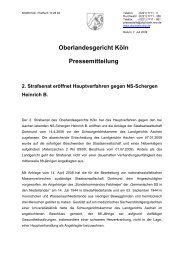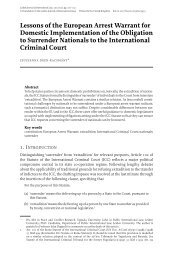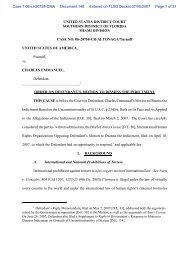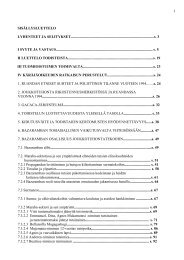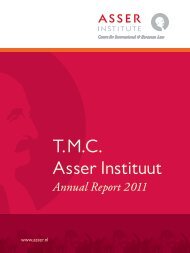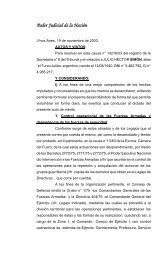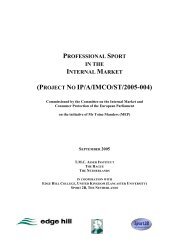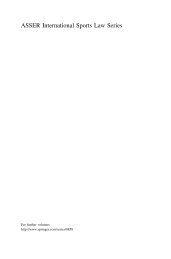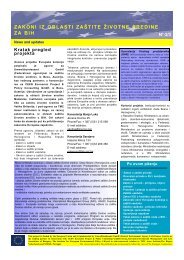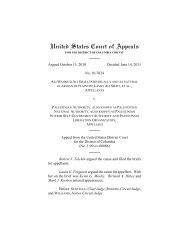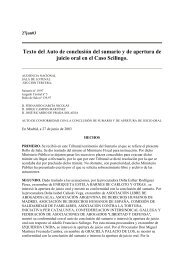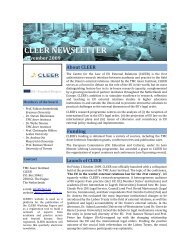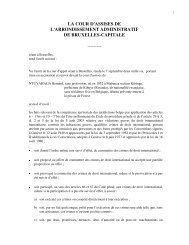Islj 2009 3-4 - TMC Asser Instituut
Islj 2009 3-4 - TMC Asser Instituut
Islj 2009 3-4 - TMC Asser Instituut
You also want an ePaper? Increase the reach of your titles
YUMPU automatically turns print PDFs into web optimized ePapers that Google loves.
In this research, the focus will be on the three-way relation between<br />
the club, agents and the players.<br />
The government is also included as the legislator, who implements<br />
different regulations on the three actors.<br />
2.3. Principal-agent problem<br />
In agency theory, the agent acts on behalf of the principal. The problem<br />
in that case, is the existence of asymmetric information. This<br />
could create a moral hazard problem, since the principal cannot perfectly<br />
observe the effort of the agent, and the agent behaves not fully<br />
in the interest of the principal (Holmstrom, 1979). The heart of<br />
agency theory is the conflict of interests, when individuals with different<br />
objectives cooperate with each other (Eisenhardt, 1989).<br />
So, there are two important features of the theory, first there must<br />
be information asymmetry and second a conflict of interest. The<br />
sports agent has more knowledge about the bargaining process than<br />
the athlete, because the experience of other negotiations. The sports<br />
agents have more knowledge about the salaries of other athletes. The<br />
sports agent, as well as the athlete, wants to maximize their own<br />
objective function. In this research, the focus will be on the profit<br />
maximizing actors, for convenience. There are other factors, which<br />
can influence the objective function of an athlete or the sports agent,<br />
but they are not included. The profit maximizing actors are resulting<br />
in the conflict of interest between a sports agent and an athlete. For<br />
example, a sports agent can make a quick deal with a club, which is<br />
more beneficial for him than for the player. To overcome the agency<br />
problems, arising from the relationship between a sports agent and an<br />
athlete, the athlete has to give the right incentives to the sports agent.<br />
As we sketched it above, it seems like a two-way relationship, but in<br />
reality there is a three-way relationship. The third party is the club. 14<br />
The traditional principal-agent problem is between the sports<br />
agent and the player, because the sports agent is acting on the behalf<br />
of the athlete. It is important to keep the role of the clubs in mind,<br />
because they need sports agents as well. The clubs need the sports<br />
agents, not only to contract a particular player, but also to attract<br />
other players in the future. The other way around, the sports agents<br />
need a club in the future, in order to obtain a contract for another<br />
player. When an athlete has a sports agent, then it is important to<br />
keep in mind that the sports agent (agent) has to do what the athlete<br />
(principal) wants. An agent has to carry out the business affairs of his<br />
principal not of himself. 15<br />
The three parties in the bargaining process have different interests,<br />
but by using the right incentives the conflict of interest between the<br />
sports agent and the athlete can be mitigated. The clubs can also try<br />
to reduce the alignment of interest between the sports agents and the<br />
athlete, in order to get a lower salary in the contract (in the interests<br />
of the clubs). The clubs could reward sports agents, when they act in<br />
their interest and not in the interest of their principal. The three-way<br />
relationship between the clubs, sports agents and the athletes is very<br />
complex and it cannot be said who has a more powerful position in<br />
the relationship.<br />
An interesting example of the relation between sports agents and<br />
players, derived from the brokers, is that the interest of the sports<br />
agent is never fully the same as from the athlete. When the sports<br />
agent gets paid by a commission of the salary, the commission is 10<br />
percent for example. When the player receives an offer of 2 million<br />
euro a year, the sports agent will receive 200.000 euro. With some<br />
effort by the sports agent the player could also receive 2,2 million. The<br />
14 Nowadays, the clubs also need the sports<br />
agents by the increasing amount of regulations,<br />
which results in more rules by<br />
making up a contract. It could even<br />
occur that the clubs assign a sports agent<br />
and the player does that as well, but they<br />
assign different sports agents. It will<br />
result in negotiations with four parties:<br />
two sports agents, the club and the player.<br />
In order to keep it simple I will stick<br />
to the three-way relation in this research.<br />
15 Only if the principal wants something to<br />
be done, which is illegal, than the agent<br />
have no duty to obey the principal<br />
(Shropshire & Davis, 2008, pp. 18-21).<br />
16 A no-claim is a regulation implying that<br />
a person gets an amount of money back,<br />
when there was no claim on the insurance<br />
for a whole year.<br />
17 When a consumer needs his insurance,<br />
there is a part of the costs which have to<br />
be paid by the consumer himself.<br />
reward for the sports agent is 20.000 euro’s, but the effort he has to<br />
do could cost more than the 20.000 euro he receives. When this is the<br />
case, he would accept the offer at 2 million euro a year. The player<br />
misses out some extra benefit, but he did not know that. It is a good<br />
example of how the interest of sports agents and players will conflict<br />
even after the commission fee. It is hard to fully align the interest of<br />
the sports agent and the player.<br />
There are two related concepts, which can be introduced in the<br />
principal-agent relationship. The moral hazard and adverse selection<br />
will be discussed now. Moral hazard could occur, because sports<br />
agents are acting on behalf of the athletes. It means that they could<br />
benefit for it, but the sports agents are not bearing the full risks.<br />
When reputation is introduced, then the sports agents are bearing<br />
risks. It depends on the discount rate of future deals and how much<br />
it affects future deals. Adverse selection could occur in the relationship<br />
athlete-sports agent or club-sports agent. There is information<br />
asymmetry in these relationships, this leads to the possibility of<br />
adverse selection.<br />
2.3.1. Moral hazard<br />
Moral hazard is a market failure, which often occurs in the insurance<br />
market. It occurs, when individuals change risk behavior, because of<br />
insurance. It could lead to a different behavior of the individual. The<br />
individual could act more risky than he would do when he was fully<br />
exposed to the risk. It could be the result of a principal-agent relationship,<br />
where the agent also not bears the full risk of his actions. The<br />
agent cannot completely monitor the agent (Arrow, 1970, pp. 220-<br />
222). When there is a conflict of interest, the agent will have an incentive<br />
to act inappropriate. So, it is important, as has been said before<br />
that the interests of the agent and the principal are aligned.<br />
An example of the insurance market will explain it better. When a<br />
consumer takes insurance from a firm, a part of his risk went to the<br />
firm. He does not have to pay all the costs for damage done by his<br />
actions. This has obviously an effect on the incentives of the consumer.<br />
The consumer will be more careless than he would be when he<br />
was fully exposed to the risk. So, more risks are taken by the consumer<br />
with the insurance. This behavior is called moral hazard, and it leads<br />
to more costs for the firms. When the moral hazard is happening very<br />
often, the market for insurance companies will fail.<br />
The difficulty is the information asymmetry between the insurance<br />
company and the consumer. The insurance company cannot monitor<br />
the consumers in the degree of risk taking (Arrow, 1963). A possible<br />
solution for the market failure in the insurance market is, for example,<br />
the introduction of the compulsory no-claim 16 regulation or compulsory<br />
deductibles. 17 The risks for the consumer would increase by<br />
such regulation, because with any damage they have to pay a part<br />
themselves or they will lose their no-claim. The increase in risks for<br />
the consumer will lead to a change in the incentives of risk taking by<br />
the consumer. The insurance companies have to deal with moral hazard<br />
through these regulations.<br />
The moral hazard problem is also present in the market of sports<br />
agents. As explained at the principalagent problem, the sports agents<br />
are acting on the behalf of the athletes. The sports agent can earn<br />
money by making a good deal, but cannot lose any money (no risk<br />
involved). The risk of the failure of a contract is born by the athlete<br />
(principal). It could lead to more risk taking by the sports agent. For<br />
sports agents, there is some risk involved, because he is investing time<br />
and money into the contracts between player and clubs. The sports<br />
agent has some costs at the beginning, but still the risks are very low.<br />
As can be seen in Figure 2, in the beginning the sports agents are<br />
investing a little money and time.<br />
The payoff is going down until the point where a contract is reached<br />
(point A). When there is a contract between the athlete and the club,<br />
the sports agent gets his commission fee and the payoff increases. When<br />
the player is renegotiating the contract with the club, the sports agent<br />
will receive a commission, which is at point B. Before the renegotiating,<br />
the sports agent has to invest some time and money to make the deal,<br />
this leads to the decrease in profits before point B. The figure is simplified,<br />
but it gives a good illustration the low risk of the sports agent.<br />
78 <strong>2009</strong>/3-4<br />
A RT I C L E S



